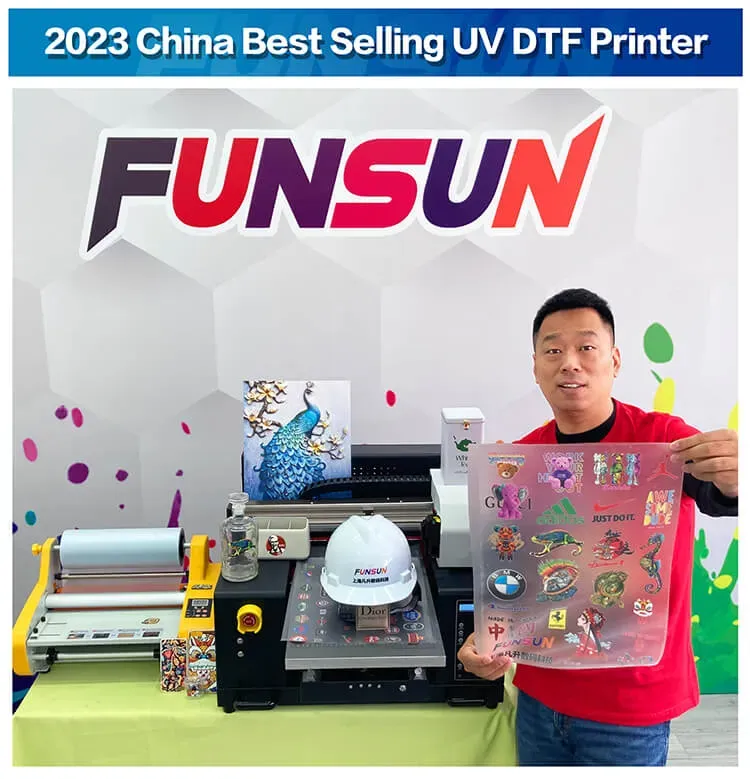UV DTF printing, short for Ultraviolet Direct-to-Film printing, represents a significant leap in the realm of UV printing technology, merging quality with efficiency for vibrant, durable custom UV prints. This method stands out by swiftly curing inks with UV light, ensuring sharp details and resilience, ideal for a variety of materials from textiles to metals. Businesses across sectors, including fashion and signage, have embraced this innovative printing approach to enhance their product offerings. With the advent of advanced printers like the EufyMake and the capabilities of Mimaki UV printers, the market is witnessing an exhilarating transformation that fuels creative potential. Understanding UV DTF printing is not just about keeping up with trends; it’s about unlocking new possibilities in personalized production.
When exploring modern printing solutions, one cannot overlook the potential of Ultraviolet Direct-to-Film printing—often termed DTF printing. This technique not only provides vibrant output but also prides itself on its ability to print on a multitude of surfaces, thanks to advancements in the field of UV printing technology. The introduction of innovative devices, such as the EufyMake printer, showcases how accessible and versatile this process can be for creatives and businesses alike. Meanwhile, established players like Mimaki continue to push the envelope, offering new roll-to-roll and flatbed printers that expand the capabilities of direct-to-film printing. By delving into the world of custom UV prints, businesses can now leverage cutting-edge technologies to meet market demands effectively.
Understanding UV DTF Printing Technology
UV Direct-to-Film (DTF) printing is a revolutionary printing method that utilizes ultraviolet light to instantly cure specially formulated inks onto a film substrate. This process allows for high-quality image reproduction with vibrant colors and intricate details, often surpassing traditional printing methods. Unlike typical DTF printing that relies on water-based inks, UV DTF utilizes UV-curable inks that permanently bond to the film, providing superior adhesion and durability. This technology has transformed the printing landscape, making it a sought-after solution for businesses across various sectors.
As businesses increasingly demand high-quality prints on diverse materials—ranging from textiles to rigid surfaces—UV DTF printing stands out by delivering on those needs. With the ability to select from a variety of substrates, including plastics, metals, and fabrics, this technology is favored for its versatility. Whether you’re a small business seeking to produce custom UV prints for clothing or a large corporation needing promotional materials, the UV DTF process promises efficient production without compromising quality.
The Advantages of UV DTF Printing
One of the most notable advantages of UV DTF printing is its exceptional durability. The prints produced through this technology exhibit remarkable resistance to fading, scratching, and weathering, making them ideal for applications that require longevity, such as outdoor signage or custom apparel. Businesses can benefit greatly from this durability, as it enhances the lifespan of products, thereby reducing the need for frequent replacements.
Moreover, UV DTF printing is considered a more sustainable option compared to conventional printing methods. The UV inks used in this process emit fewer volatile organic compounds (VOCs), aligning with the industry’s growing emphasis on eco-friendly practices. As consumers become increasingly aware of environmental issues, utilizing technologies like UV printing not only enhances brand reputation but also caters to the ethical preferences of customers.
Latest Innovations in UV DTF Printing Equipment
In recent years, there has been a wave of innovative products introduced to the UV DTF printing market, notably the eufyMake UV Printer E1. This printer represents a significant advancement as it merges the capabilities of a flatbed with that of a rotary printer, allowing for a diverse array of applications. By facilitating the creation of tactile 3D textures, the eufyMake printer opens new avenues for customization, making it ideal for artists and small business owners looking to distinguish their offerings in a competitive market.
The unveiling of new machines by brands such as Mimaki at industry events like the Fespa Global Print Expo signals an ongoing commitment to innovation in UV DTF printing technology. With new roll-to-roll printers capable of producing high-quality prints efficiently, these advancements reflect the industry’s response to the rising demand for personalized and customized print solutions. As technology continues to evolve, businesses can expect even greater speed and quality in their printing operations.
Key Applications of UV DTF Printing
The versatility of UV DTF printing opens up a vast range of applications across various industries. In the fashion sector, custom apparel and accessories can be created with intricate, high-resolution designs that appeal to a style-savvy consumer base. This technology enables fashion designers to bring their creative visions to life, allowing for unique and personalized fashion statements that stand out in the crowded market.
Another prominent application for UV DTF printing is in signage production. Traditional signage often faces challenges with weather resistance and durability; however, UV DTF prints are optimized to withstand environmental factors such as sun exposure and rain. This makes them an ideal choice for businesses looking to create eye-catching outdoor signs that maintain their appearance over time, enhancing brand visibility and customer engagement.
Emerging Trends in UV DTF Printing
Several trends are shaping the landscape of UV DTF printing as the industry evolves. Customization has emerged as a significant trend, with consumers increasingly seeking personalized products tailored to their unique preferences. UV DTF printing technology enables manufacturers to meet this demand effectively, allowing for rapid production of customized designs that resonate with individual customers.
Sustainability is another crucial trend influencing the UV printing sector. As awareness of ecological issues rises, more companies are seeking to adopt practices that minimize environmental impact. This has led to the development of greener UV inks and better manufacturing processes. By leveraging sustainable UV DTF printing, companies not only reduce their carbon footprint but also appeal to eco-conscious consumers who favor businesses demonstrating social responsibility.
Maximizing Productivity with UV DTF Printing
To fully capitalize on the advantages of UV DTF printing, businesses must implement strategies that streamline production processes. This could include investing in high-quality printers like the latest models from Eufy or Mimaki, designed for efficiency and precision. By ensuring they have the right equipment, businesses can increase their output while maintaining quality, ultimately leading to cost savings and enhanced profitability.
Additionally, integrating software that optimizes workflow can significantly improve productivity. Automation in design preparation and print management allows companies to reduce downtime and expedite the print-to-production process. By embracing technological advancements, businesses can maintain a competitive edge in today’s fast-paced market, ensuring they meet client demands without sacrificing quality or efficiency.
Frequently Asked Questions
What are the key benefits of UV DTF printing compared to traditional printing methods?
UV DTF printing offers several key benefits over traditional methods, including superior print durability due to UV-curable inks that resist fading and scratching. Additionally, UV DTF printing is versatile, allowing businesses to print on a wide range of materials, from textiles to plastics and metal. This cutting-edge UV printing technology also supports sustainability by emitting fewer VOCs, making it an eco-friendly choice for manufacturers.
How does the eufyMake UV printer utilize UV DTF printing technology?
The eufyMake UV printer is designed specifically to harness the capabilities of UV DTF printing technology. It allows for the creation of detailed images on special films before transferring them onto diverse substrates. This innovative printer also enables users to produce three-dimensional textures, opening up new creative possibilities and enhancing the versatility of custom UV prints.
In what industries is UV DTF printing gaining traction?
UV DTF printing is gaining traction in various industries, including fashion, where custom apparel is created with vibrant graphics, and signage, where durable prints withstand outdoor conditions. It’s also being used in home decor, allowing for tailored and personalized items that enhance living spaces. The technology’s versatility positions it as a vital tool across multiple sectors.
What recent advancements have been made in UV DTF printing technology?
Recent advancements in UV DTF printing technology include the launch of new models, such as those unveiled by Mimaki at the Fespa Global Print Expo. These models incorporate improved efficiency and customization abilities, catering to the rising demand for unique printed merchandise. Innovations like the eufyMake printer introduce features such as 3D printing capabilities, further broadening the scope of UV printing applications.
How does UV DTF printing support sustainability in the printing industry?
UV DTF printing supports sustainability through the use of UV-curable inks, which emit fewer volatile organic compounds (VOCs) than traditional solvent-based inks. This contributes to a healthier printing environment and aligns with the growing demand for eco-friendly practices in the industry. Manufacturers can thus promote their eco-conscious efforts by adopting UV DTF technology.
What should businesses consider when investing in UV DTF printing equipment?
When investing in UV DTF printing equipment, businesses should consider factors such as the versatility of the printer to handle various substrates, the quality of prints it produces, and energy efficiency. Additionally, they should research brand reliability, such as the use of Mimaki UV printers, and assess the potential for customization and creative applications to meet market demands.
| Key Point | Description |
|---|---|
| What is UV DTF Printing? | A printing method using UV curable inks on special films for vivid, durable prints. |
| Advantages | 1. Versatility: Suitable for various materials. 2. Durability: Resistant to fading and weathering. 3. Eco-Friendly: Emits fewer VOCs than traditional inks. |
| Latest Innovations | Introducing the eufyMake UV Printer E1 and new models by Mimaki enhancing creative potentials. |
| Potential Applications | Fashion, signage, and home decor, providing extensive creative possibilities. |
| Industry Trends | 1. Customization: Growing demand for personalized products. 2. Sustainability: Shift towards eco-friendly practices. 3. Technological Integration: Enhanced precision and efficiency. |
Summary
UV DTF printing is transforming the realm of printing technologies with its remarkable ability to create vibrant and long-lasting prints on a myriad of surfaces. This advanced technique combines the quality of UV inks with a direct-to-film application, making it suitable for diverse industries like fashion, signage, and home decor. The numerous advantages, such as versatility and durability, position UV DTF printing as a frontrunner in eco-conscious practices. With continuous innovations and industry trends steering towards customization and sustainability, UV DTF printing stands out as a game-changer that meets the evolving demands of consumers and businesses alike.



